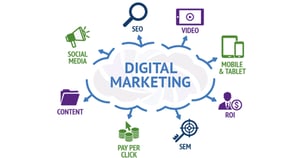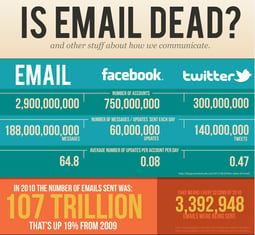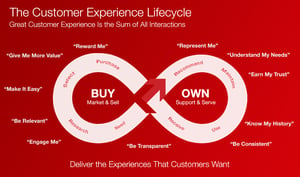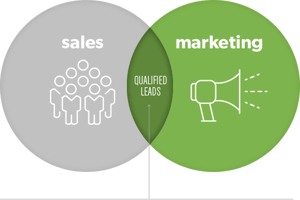Worldwide adoption of the internet into our everyday lives has made massive impacts on the marketing world. Over the past 30 years, digital marketing has been on the rise and as home builders, now more than ever, you need to be embracing all that digital marketing can do for your business.
 Hubspot defines digital marketing as ‘all marketing efforts that use an electronic device or the internet. Businesses leverage digital channels such as search engines, social media, email, and other websites to connect with current and prospective customers.’ The best digital marketers have a clear picture of how each digital marketing campaign supports the overarching goals.
Hubspot defines digital marketing as ‘all marketing efforts that use an electronic device or the internet. Businesses leverage digital channels such as search engines, social media, email, and other websites to connect with current and prospective customers.’ The best digital marketers have a clear picture of how each digital marketing campaign supports the overarching goals.
But in an industry that's been dominated by word-of-mouth referrals for decades, how can we as home builders know for sure we're getting our money's worth when it comes to digital marketing?
The digital marketing landscape is rapidly changing.
10 years ago you probably wouldn’t have believed the majority of homebuyers would be searching for new homes on a 2"x4" mobile device in their pocket. Nor would you have believed that homebuyers would be virtually touring homes online well before seeing it in person. The way we use the internet and the rapid pace at which technology is developing means that the digital marketing landscape is constantly evolving. At the Bokka Group, we have a pulse on what is and isn’t working in home building digital marketing in 2019 and we’re here to debunk the myths that many have fallen prey to.
Myth #1: High traffic to your website = a successful website
 So you’ve got a website. You’ve been using this website for the past 4-5 years and you check your google analytics every now and then and you’re pleased with the number of visitors that are finding your site. So you’re all set! Well, not quite. Just because you’ve got high traffic coming to your site doesn’t necessarily mean that your website is working for you. In fact, in digital marketing, one of the best ways to measure a successful website is to measure the number of conversions on your site. (Here's more information about average home builder sales conversion rates.)
So you’ve got a website. You’ve been using this website for the past 4-5 years and you check your google analytics every now and then and you’re pleased with the number of visitors that are finding your site. So you’re all set! Well, not quite. Just because you’ve got high traffic coming to your site doesn’t necessarily mean that your website is working for you. In fact, in digital marketing, one of the best ways to measure a successful website is to measure the number of conversions on your site. (Here's more information about average home builder sales conversion rates.)
In home building, we believe that website conversion is going to be the most important factor in the success of your online digital marketing strategy and goals. This means that visitors coming to your site ultimately identify themselves to you as leads, whether that’s by making an appointment, requesting more info, signing up for a newsletter, downloading a whitepaper/article, or requesting more information about your homes or communities. You should be offering all visitors to your website multiple opportunities to convert in order to increase the likelihood of gaining a lead for your sales team. So perhaps you’re realizing that this website you’ve been working with for the past few years isn’t actually working so well for you after all. Maybe it’s time to consider a new website. If you're just not sure - read this article about home builder website design.
Myth #2: Email is dead
 Is email dead? Jimmy Diffee explores this idea in his article, Is Email Dead, informing us that according to a comprehensive survey of homebuyers in our Home Buyer Conversion Report, buyers indicated that email is still one of the most influential digital tools they use when researching a new home purchase. He goes on to state that in fact,
Is email dead? Jimmy Diffee explores this idea in his article, Is Email Dead, informing us that according to a comprehensive survey of homebuyers in our Home Buyer Conversion Report, buyers indicated that email is still one of the most influential digital tools they use when researching a new home purchase. He goes on to state that in fact,
Email outranked social media (by a lot). One of the benefits of an email campaign is the immediate feedback you’ll receive from home buyers. Launch a campaign in almost any other medium and you may have to wait days, weeks, or months to know if the message is resonating with home buyers. Email often provides feedback within hours, with instant answers to key marketing questions such as:
- Was my message compelling? (Open rate)
- Was my offer compelling? (Click through rate)
- Which messages do my buyers care about most? (Clicked links)
- Which prospects on my list are most engaged? (Detailed recipient activity reports)
Beyond the data you can get from emails, an email marketing campaign also gives you the opportunity to reach home buyers on a more personal level than other mediums. You can personalize emails based on say, first-time homebuyers, demographics (is this a baby-boomer or millennial audience?), families or empty nesters, and so forth. Knowing your audience is important in crafting a successful email campaign. If you’re looking to step up your email campaign game, I highly recommend reading more about 3 high-performing prospect emails you should be sending.
Myth #3: Customer experience or (CX) has nothing to do with our digital marketing strategy
 Customer Experience - also referred to as CX. You’ve likely seen this abbreviation popping up left and right (there’s a great article on CX as the new brand in Forbes). Needless to say, CX is becoming central to beating out the competition no matter what industry you’re in, but it’s especially important in homebuilding. While it may seem that your CX is only relevant to in person or over the phone interactions with your homebuyer, in reality, CX has everything to do with digital marketing. It starts from the minute a prospect identifies him or herself as a lead to you.
Customer Experience - also referred to as CX. You’ve likely seen this abbreviation popping up left and right (there’s a great article on CX as the new brand in Forbes). Needless to say, CX is becoming central to beating out the competition no matter what industry you’re in, but it’s especially important in homebuilding. While it may seem that your CX is only relevant to in person or over the phone interactions with your homebuyer, in reality, CX has everything to do with digital marketing. It starts from the minute a prospect identifies him or herself as a lead to you.
When you receive a completed form from your website say, requesting for more info about a floor plan, what chain of events does this trigger internally?
Do you have an automated email that goes out? A personalized email or a follow-up phone call from a sales consultant? Is your team member reviewing the form and providing the prospect with the information they’ve requested (and not asking for additional information that they’ve already provided). All of this is a part of your CX plan and it ties right into all things digital marketing. Furthermore, knowing what your CX metrics are (and should be) is an important part of understanding the success of CX and marketing strategies. It may seem obvious, but improving your overall CX is without a doubt going to improve your reviews online and your digital brand.
Myth #4: Augmented and virtual reality technologies aren't worth the investment
 It should come as no surprise that the Real Estate and Homebuilding industries have jumped on the AR and VR train - and for good reason. These technologies allow homebuyers to really get a feel for a home - inside and out - from the comfort from their own home. A recent Forbes article puts it nicely saying, ‘before long, you’ll be able to attach a VR headset to your phone and get an open house experience without having to go to the property in person.’ Companies like RoOomy and Roomored (yes, different companies) have developed technologies for virtual staging so that homebuilders can cut costs on physical staging and have the ability to stage one listing in multiple aesthetics.
It should come as no surprise that the Real Estate and Homebuilding industries have jumped on the AR and VR train - and for good reason. These technologies allow homebuyers to really get a feel for a home - inside and out - from the comfort from their own home. A recent Forbes article puts it nicely saying, ‘before long, you’ll be able to attach a VR headset to your phone and get an open house experience without having to go to the property in person.’ Companies like RoOomy and Roomored (yes, different companies) have developed technologies for virtual staging so that homebuilders can cut costs on physical staging and have the ability to stage one listing in multiple aesthetics.
And if you’re thinking that AR and VR technologies won’t be worth the investment, we’re here to tell you they’re no longer the exception - they’re becoming the rule. And as the technologies advance, we predict the cost to you will continue to decrease. We’ve been particularly impressed by Matterport’s statistics as Matterport Director of Commercial Real Estate Marc Rehberger states that their 3-D walkthrough technologies on ads “ increases the amount of time spent on an ad between three to six times when there’s a Matterport model on that ad. ... It’s very, very sticky.” The investment alone of this technology in digital ads has the potential to transform your conversions and qualified leads.
Myth #5: More leads = more sales
 Everyone is not your customer. One of the biggest challenges to homebuilders (and all businesses, really) is identifying your target audience. Who are the people who need, want and are most likely to purchase what you are offering? Simply put, targeted marketing is going to give you a better return. And more often than not, most home builders at some point in time are going to need some outside help in this arena. It’s important to spend time identifying your target audience before you begin marketing.
Everyone is not your customer. One of the biggest challenges to homebuilders (and all businesses, really) is identifying your target audience. Who are the people who need, want and are most likely to purchase what you are offering? Simply put, targeted marketing is going to give you a better return. And more often than not, most home builders at some point in time are going to need some outside help in this arena. It’s important to spend time identifying your target audience before you begin marketing.
Similar to knowing your audience for email campaigns mentioned earlier, it’s important to know who to design your website and digital ads for. Are they retirees who use bifocals and need larger text? Are they millennials who are expecting Virtual Tours and instant responses? Are they young families who are looking for a playroom and mudroom for the inevitable messes that are sure to fill their new home? Knowing your target audience can have an enormous impact on conversions and reaching the customer, which plays into the customer experience you’re offering. When a prospect feels known and understood by a company or brand, the likelihood they’ll convert as a homebuyer with you increases tenfold.
So what's the end goal? More qualified leads
Ultimately, all of these myths we’ve debunked are above all working toward the same goal: not just more leads, but more qualified leads that have a better understanding of your brand - who you are, what you do, what you value and why.
When your digital marketing strategy is working for you around the clock and doing what it should be doing, ultimately your prospects will be confident that they’ve chosen the best builder for their needs. And you can rest assured you’re doing everything right.
Need a helping hand with your digital marketing?
Bokka Group is here help take your digital marketing plan to the next level. Drop us a line - we'd love to hear your story.


